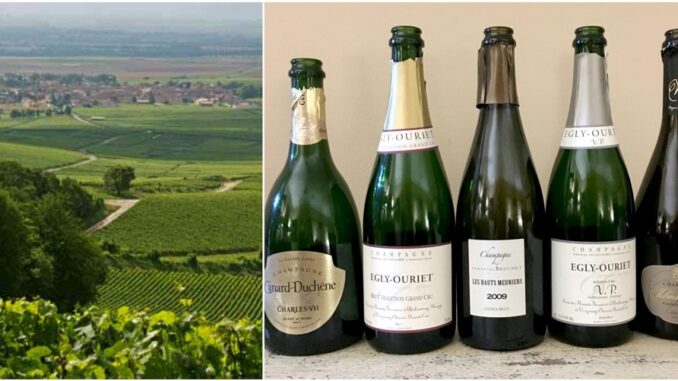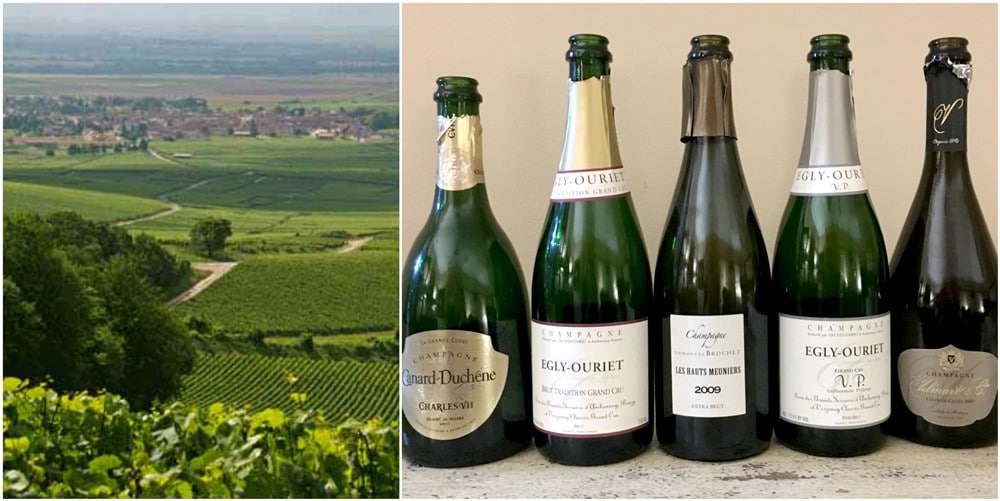
A lesson in champagne from the Montagne de Reims is often a comparison of apples with apples. The black-skinned variety – pinot noir – dominates here, producing blanc de noirs of single-minded intensity, power and structure on mostly chalk-rich, south-facing slopes.

Bouzy, Verzenay and Ambonnay rank among my favourite villages for this variety; the former two for their density and drive and the latter for its roundness. Energy is another descriptor I associate with pinot noir from these villages which, for me, is a key point of difference when comparing with pinot noir from the Aube – in Champagne’s deep south.
But the region’s appeal doesn’t begin and end with pinot noir. Less common growths, chardonnay and meunier, often produce some very interesting and unexpected results. Chardonnay is rounder, riper and fuller in the Montagne de Reims making it more luscious and approachable even when young. And meunier can be almost mystical – dense, dark and ‘wet’ with forest floor.
The region is a kaleidoscope of complexity for all three key grape varieties, confirming the region’s status as ‘King’ of the Champagne kingdom.
Read more in the book “The Finest Wines of Champagne: A Guide to the Best Cuvées, Houses, and Growers“
At a recent champagne tasting, we explored all three varieties from this most remarkable aspect of Champagne’s terroir. My tasting notes follow.
Canard Duchene Charles VII Blanc de Noirs
70% pinot noir and 30% meunier including 20% reserve wines. Bottles are aged for four years on lees and receive a dosage of 11g/L
Appearance – Medium gold with a small bead.
Nose – A lightly pronounced nose, but quite youthful and primary. There is some appearance of red apples, florals and a hint of spice.
Palate – This medium-body champagne is fine and elegant, in a style that one may expect from a major House. What strikes me is how well organised it is. Medium levels of acidity dovetail nicely with the ripeness of fruit, notably red apples and summer fruit platter, complemented by a sprinkling of white pepper spice and pastries. The expression isn’t powerful, as one may expect, instead revealing a pretty – more feminine – profile that is fresh, calm and poised. Its sense of lightness and freshness could make it pass as an aperitif. There are good levels of flavour intensity that build, but it doesn’t hold a pinot noir ‘backbone’ that is typical for a blanc de noirs. Nonetheless, it’s incredibly enjoyable with enough complexity and good balance. It leads to a medium-plus finish that is fresh and clean.
Egly-Ouriet Brut Tradition Grand Cru NV
Comprises 70% pinot noir and 30% chardonnay taken from Ambonnay, Bouzy and Verzenay. 80% is fermented in oak before spending four years on lees, disgorged in July 2016. Bottles are given a dosage of 3-4g/L.
Appearance – Deep gold with a small bead.
Nose – A pronounced first nose of honeyed stone fruits and toast, followed by some tropical notes including coconut.
Palate – A highly vinous, luscious and full-bodied wine. Chardonnay from the Montagne de Reims assists with producing its rounded, creamy, and full expression, before opening up to candied orange, dried fruits and red cherries. Medium-plus levels of acidity combine with chalky-saline minerality to keep it all so precise and well structured. The finish is long, pure and mouth-watering. Such a joy to drink.
Emmanuel Brochet Les Hauts Meuniers 2009 Extra Brut
Comprises 100% meunier taken from a single parcel in Le Mont Benoit, his oldest vines dating back to 1962. Juice is fermented in oak, malolactic fermentation is blocked and then left to rest on lees until bottling 16 months after harvest. There is no fining or filtration. Each bottle spends four years on lees and given a dosage of 2.5g/L.
Appearance – Deep gold with a fine bead.
Nose – A pronounced nose of secondary and tertiary delights with highlights of butterscotch, wet earth, and purple flowers.
Palate – An incredibly engaging, complex and almost hedonistic wine revealing the many faces of meunier. Forget what you know of this grape variety and come taste this! A full-bodied and vinous expression of earthy delight: forest floor, deep purple flowers, and wet stones / slate-like minerality, lifted with a rainforest freshness and grapefruit acidity. A subtle butterscotch and toast emerge to add complexity and fullness to this most interesting wine. At the centre lay a very strong and persistent core that builds in profile throughout the tasting. It makes for excellent balance, leading to a long, flavoursome and sensual experience.
Egly-Ouriet Grand Cru VP (Vieillissement Prolonge) NV
Comprises 70% pinot noir and 30% chardonnay from Ambonnay, Bouzy, and Verzenay. The base wine is taken from the 2007 vintage and includes 60% reserve wine from 2006 and 2005. Fermentation takes place in oak casks before receiving extended lees ageing of nearly 7 years (82 months). Disgorged May 2016. Bottles receive a dosage of 3g/L.
Appearance – Deep gold with a prolific bead and excellent mousse.
Nose – A nose of some intensity and complexity, highlighting all the goodness of autolysis. Brioche, toast, roasted nuts, and candied fruits set the scene.
Palate – A vinous and mature wine of great proportions and appeal. Dried and cooked fruits mingle with honeyed pastry and brioche, punctuated with floral notes. There is a sense of purity, drive and intensity to this wine, that also boasts Egly’s trademark mineral profile. The finish is long, direct and intense, leaving a clean and mineral touch.
Vilmart & Cie Coeur de Cuvee 2005
Comprises 80% chardonnay and 20% pinot noir from old vines in Rilly la Montagne. Fermented and matured in young oak for 10 months. Bottles are given a dosage of 8g/L.
Appearance – Deep gold with a fine bead.
Nose – All the splendours of chardonnay abound here with a pronounced and creamy nose of white flowers, yellow and white stone fruits, and autolysis. The second nose reveals a profile of wet slate minerality.
Palate – A full-bodied, rounded, and vinous wine showcasing the best of chardonnay from this northerly part of the mountain. Flavours of yellow stonefruits and toffee apple are given weight and complexity with finely integrated oak. Full and wide on execution, a tempered lemon acidity and intensity from pinot noir gently persuade its course. The ending is long, mineral and refined, making this a champagne of exemplary elegance.
